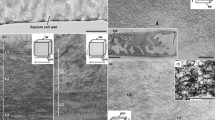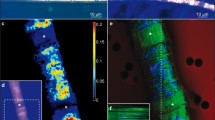Abstract
Electron microscopy, in conjunction with X-ray microanalysis, was used to investigate the effects of exposure to cadmium on the elemental composition of the macroalgaUlva lactuca. The cell wall was the only region of the cell to show any marked change in chemical composition as a result of exposure to cadmium, with less calcium evident in cadmium-treated thallus compared with untreated thalli. The cell wall ofU. lactuca is a complex structure made up of polysaccharides consisting of many-branched chains composed mostly of rhamnose and galactose subunits. Some of the hydroxyl groups on the subunits are substituted by sulphate groups. Borate is associated with the rhamnose subunits, which contain no sulphate groups, and calcium binds to borate, cross-linking the rhamnose groups. The borate-calcium complex adds rigidity to the cell wall; the replacement of calcium by cadmium will, therefore, influence the rigidity of the thallus. The ecological significance of this work is discussed with respect to the ability of the alga to withstand grazing or emersion.
Similar content being viewed by others
References
Crist RH, Martin JR, Carr D, Watson JR, Clarke HJ, Crist DLR. 1994 Interactions of metals and protons with algae.Environ Sci Technol 28, 1859–1866.
Greene B, Darnall DW. 1990 Microbial oxygenic photoautotrophs for metal-ion binding. In: Ehrlich HL, Brierley CL, ed.Microbial Mineral Recovery. New York: McGraw Hill; 277–302.
Haug A. 1976 The influence of borate and calcium in the gel formation of a sulphated polysaccharide fromUlva lactuca.Acta Chem Scand 30, 562–566.
Hay ME, Kappel QE, Fenical W. 1994 Synergisms in plant defenses against herbivores—interactions of chemistry, calcification and plant-quality.Ecology 75, 1714–1726.
Hughes MN, Poole RK. 1991 Metal speciation and microbial growth—the hard (and soft) facts.J Gen Microbiol 137, 725–734.
Kierans M, Staines AM, Bennett H, Gadd GM. 1991 Silver tolerance and accumulation in yeasts.Biol Met 4, 100–106.
Kloareg B. 1991 Structure and ion-exchange properties of the cell-walls of brown-algae—ecophysiological significance.Bull Soc Botan France-Actualites Botan 138, 305–318.
Kloareg P, Demarty M, Mabeau S. 1987 Ion exchange properties of isolated cell walls of brown algae: the interstitial solution.J Exp Bot 38, 1652–1662.
Lobban CS, Wynn MJ. 1981The Biology of Seaweeds. Oxford: Blackwell Scientific Publications.
McLean MW, Williamson FB. 1977 Cadmium accumulation by the marine red algaPorphyra umbilicalis.Physiol Plant 4, 268–272.
Mariani P, Tolomio C, Braghetta P. 1985 An ultrastructural approach to the adaptive role of the cell wall in the intertidal algaFucus virsoides.Protoplasma 128, 208–217.
Mariani P, Tolomio C, Baldan B, Braghetta P. 1990 Cell wall ultrastructure and cation localisation in some benthic marine algae.Phycologia 29, 253–262.
Percival E. 1979 Polysaccharides of green, red and brown seaweeds; their basic structure, biosynthesis and function.Br Phycol J 14, 103–117.
Reed RH, Gadd GM. 1990 Metal tolerance in eukaryotic and prokaryotic algae. In: Shaw J, ed.Heavy Metal Tolerance in Plants—Evolutionary Aspects. Boca Raton, FL: CRC Press; 106–118.
Reynolds ES. 1963 The use of lead citrate at high pH as an electron-opaque stain in electron microscopy.J Cell Biol 17, 208.
Ritchie RJ, Larkum AWD. 1982 Cation exchange fluxes of the cell walls ofEnteromorpha intestinalis (L.).J Exp Bot 132, 140–153.
Schupp PJ, Paul VJ. 1994 Calcium-carbonate and secondary metabolites in tropical seaweeds—variable effects on herbivorous fishes.Ecology 75, 1172–1185.
Skowronski T, Szubinska TA. 1991 The Influence of pH on Cd toxicity to the green algaStichoccocus bacillaris and on the cadmium forms present in the culture medium.Environ Pollut 74, 89–100.
Volesky B. 1990 Removal and recovery of heaty metals by biosorption. In: Volesky B, ed.Biosorption of Heavy Metals. Boca Raton, FL: CRC Press; l8–43.
Webster EA, Gadd GM. 1992 Cadmium as an uncoupler of respiration ofUlva lactuca.Environ Toxicol Water Qual 7, 189–200
Webster EA, Gadd GM. 1996 Stimulation of respiration ofUlva lactuca by high concentrations of zinc: evidence for an alternative respiratory pathway.Environ Toxicol Water Qual,11, 7–12.
West KR, Pitman MG. 1967 Izonic relations and ultrastructure inUlva lactuca.Aust J Biol Sci 20, 901–914.
Author information
Authors and Affiliations
Rights and permissions
About this article
Cite this article
Webster, E.A., Gadd, G.M. Cadmium replaces calcium in the cell wall ofUlva lactuca . Biometals 9, 241–244 (1996). https://doi.org/10.1007/BF00817922
Received:
Accepted:
Issue Date:
DOI: https://doi.org/10.1007/BF00817922




